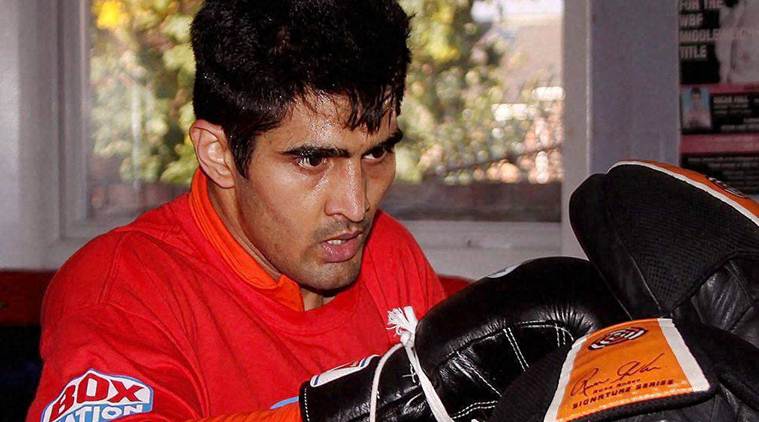Vijender Singh in and out in 3 minutes
Vijender Singh, after his three round knockout win in first bout, wins second bout by first round knockout.
 Vijender Singh won his second professional bout. (Source: PTI file)
Vijender Singh won his second professional bout. (Source: PTI file)
Vijender Singh followed up an impressive debut with an even more dominating performance in his second professional fight against Dean Gillen in Dublin. He had won his professional debut against Sonny Whiting when the referee had stopped the fight in the third round of a four-round contest. Gillen lasted only a third as long.
A flurry of combination punches had sat him down in a corner of the ring in the dying seconds of the first round. As the referee counted him out, the Nottingham-based boxer sat on his haunches, leaning against ropes, his heart clearly no longer in the fight.
For any professional prospect the early fights are all about figuring out areas to improve on. They are also about showcasing the pugilist’s strengths. At the end of his second bout, Vijender appeared to have ticked a few more boxes in the learning column while putting on display the power he brought to the middleweight division.
In his first bout against Whiting, Vijender’s quick feet had played the most visible role. They left his opponent punching at shadows. However many observers felt that Vijender had moved too much. By leaving his weight on the balls of his feet, he wasn’t able to get the kind of power he would have if he punched off his heels.
It isn’t as pretty as the amateur style but it gets the job done. Vijender was noticeably more flatfooted compared to his debut, but he appeared to have found a balance. He wasn’t dancing around the ring but he made he was constantly moving in and out of danger judging distance perfectly and preventing Gillen from getting his range.
Gillen had spoken before the contest about throwing Vijender’s game off balance by making use of his superior reach to throw his jab. Gillen, to his credit, gamely tried to advance for much of the contest, but this mostly made things easier for the Indian.
A longer reach is only useful if you punch at the same time or before of your rival and Vijender had the far quicker hands amongst the two. It also doesn’t do much good if your opponent is more accurate. Indeed when jabs were exchanged, Vijender’s ramrods landed square on target even as Gillen’s left hit the Indian’s mitts.
Vijender made his accuracy count, following up with punishing blows to the body. If in his first bout, he seemed to punch at his opponent, he was punching through the target this time around. The last of three overhand right’s slammed Gillen to the canvas with a minute, twenty seconds in the round. Though stunned, Gillen got back to his feet, even as the referee inexplicably failed to start the count.
Vijender who seemed to know the hunt was about to end, wasn’t perturbed. Indeed even while his dominance was obvious, Vijender showed a calculating calmness as he made sure he closed every avenue of escape. He didn’t rush his punches. Even when he had Gillen on the ropes, he had his outer foot turned a half step away from his opponent so he could pivot out of reach quickly if ever he needed to get out of range quickly.
The end came soon enough. A overhead right stunned Gillen and a body shot from Vijender’s same hand knocked the wind out. A left hook was followed by a right that left Gillen on the ropes for one final swarm of punches that brought the match to a swift finish.































